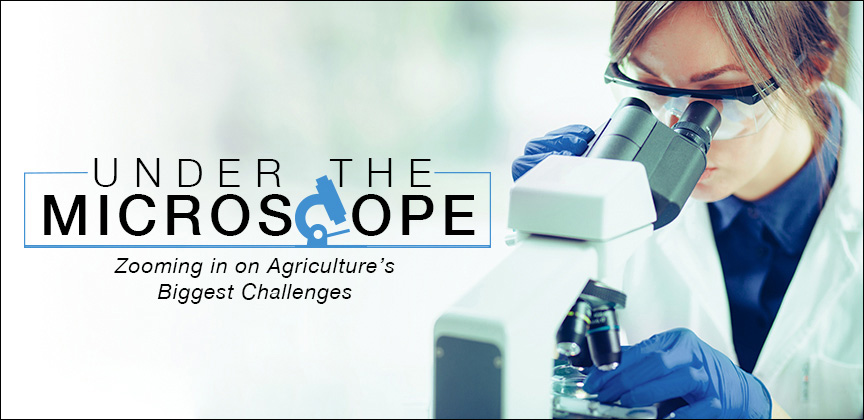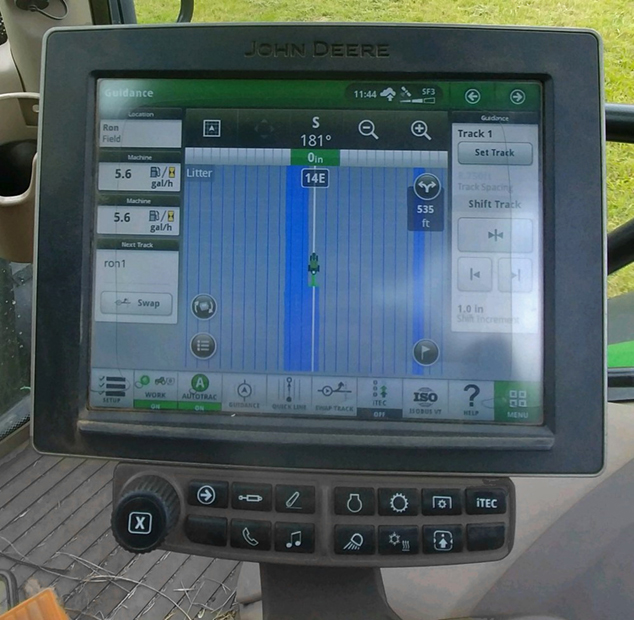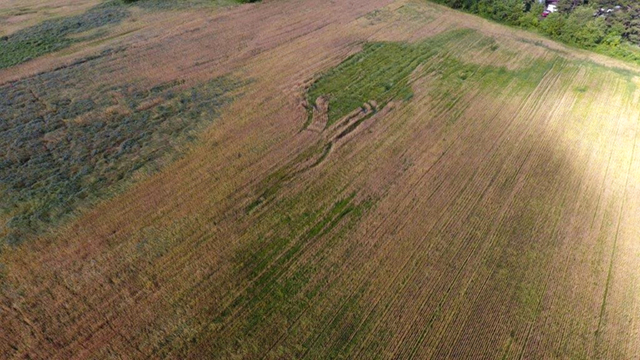
Benefits and Evolution of Precision Agriculture
 |
Drs. Amanda Ashworth and Philip Owens are researchers in ARS's Poultry Production and Products Safety Unit and the Dale Bumpers Small Farms Research Center located in Fayetteville and Booneville, AR, respectively. Their precision agriculture work focuses on developing tractor guidance systems for better resource management on farms. |
Welcome Drs. Ashworth and Owens to Under the Microscope:
UM – What is precision agriculture?
AA – Precision agriculture is a general term to describe farming tools based on observing, measuring, and responding to within-field variability via crop management. It is made possible through the use of Global Positioning System (or GPS satellites) or Global Navigation Satellite System (GNSS), which enable farm managers to respond to field irregularities. This approach allows farmers to make important resource management decisions both on-site and in real-time.
UM – Is this a new way of farming, or is it a concept that's been around for decades?
PO – The concept has been around for decades; however, the tools to put precision agriculture into practice are increasing exponentially. As scientists, our job is to help condense tools and practices and evaluate their effectiveness.
In the U.S., larger farms are increasing their use of precision agriculture and overcoming technology barriers to implement practices. But very few small farms in the U.S., which make up greater than 85 percent of U.S. farm totals, have adopted precision agriculture. Our work is specifically focused on small farmers and tractor guidance systems.
UM – How can precision tech help agriculturists, especially small farmers?
PO – Roughly half of the country's large-scale row crop producers use tractor guidance. In contrast, small farms are largely not adopting tractor guidance technologies.
There is substantial room for increased adoption on small farms, which would potentially lead to economic and environmental savings because decreases in costs often lead to increases in profits. We have learned that on-farm efficiency is especially effective for these small-scale systems. Tractor guidance offers more spatially precise understanding of tractor operations, which lead to reduced operator fatigue, higher yield, and the ability to work longer workdays during inclement conditions. Altogether, these changes may significantly lessen a small farm's fuel, labor, repair, and maintenance costs.
 A tractor tills a cover crop as part of a field trial for a tractor-guidance system experiment at the ARS Dale Bumpers Small Farms Research Center, Booneville, AR. Photo by Larry Huddleston
A tractor tills a cover crop as part of a field trial for a tractor-guidance system experiment at the ARS Dale Bumpers Small Farms Research Center, Booneville, AR. Photo by Larry Huddleston
Not all agricultural sectors receive information on technology at the same rate. There is a need for identifying potential adoption and appropriateness of technologies that can automate production while improving the economic and environmental impacts of production systems at all scales. The small farm systems have the greatest potential for adoption and will impact the greatest numbers of farms that's why we are promoting 'big data for small-scale farmers.'
UM – What are some examples of precision agriculture?
AA – Tractor guidance (also called autosteer) is a precision agriculture technology that uses GPS and can result in accuracy within one centimeter when planting, spraying herbicide, or applying fertilizer. This improved precision during field activities can result in fewer overlaps (areas in the field with double application) and gaps (or skipped areas in the field) and overall improved efficiencies (both economic and environmental).
Another example of a precision agriculture tool is variable rate technology, which allows crop producers to apply variable rates of fertilizer across a field. Similarly, yield monitoring systems record yield data (grain and grain moisture) on a combine during harvesting. Today's yield monitoring systems provide operators with a user interface that includes a spatial map that displays the grain yield of the harvested portions of the field. Both these technologies provide farmers with additional farm-level information for managing risk and more precisely managing fertilizer, seed, and herbicide.
 The tractor-guidance screen as seen during a fertilizer application; the blue lines are the areas covered by the tractor. Photo by Dr. Mike Popp, University of Arkansas
The tractor-guidance screen as seen during a fertilizer application; the blue lines are the areas covered by the tractor. Photo by Dr. Mike Popp, University of Arkansas
UM – Regarding precision agriculture generally and the tractor guidance system specifically, how do large farms differ from small ones?
PO – Large farms tend to have larger fields with row crop agriculture. Small farms can vary from forages to orchards to specialty crops to row crops, so they may be extremely diverse. This diversity requires us to think about research and technology in a different way. Also, input costs can spread out on large farms to absorb the technology investment where small farms may not have this ability.
 An ARS team in Arkansas developed a method of analysis for comparing tractor-guidance systems to driving without tractor guidance. The focus of the research is to help small farmers apply fertilizer, seed, and herbicide with more precision and less waste. The image shows the difference in fertilizer overlap (red) when the tractor-guidance system is off (left) versus when it is on (right).
An ARS team in Arkansas developed a method of analysis for comparing tractor-guidance systems to driving without tractor guidance. The focus of the research is to help small farmers apply fertilizer, seed, and herbicide with more precision and less waste. The image shows the difference in fertilizer overlap (red) when the tractor-guidance system is off (left) versus when it is on (right).
UM – Do the benefits of precision agriculture reach consumers?
AA – Tractor guidance systems can be profitable for small farms and improve efficiency gains by 20 percent. This technology can potentially improve environmental sustainability by reducing the over application of fertilizers, seed, and herbicide.
For example, if poultry litter or inorganic fertilizer overlaps and gaps were reduced by 20 percent, this would have substantial water quality benefits by reducing the potential for nutrient runoff. Based on our work, tractor guidance can improve economic gains by simply improving on-farm efficiencies. These economic and environmental gains should result in better quality products at competitive prices.
UM – What are the potential economic and environmental impacts of the tractor guidance system you are developing?
AA – Our team (along with Dr. Mike Popp at the University of Arkansas) developed a decision support tool called "Tractor Guidance Analysis," which helps optimize on-farm decision making for improved economic and environmental impacts using tractor guidance systems. We are also performing research to identify actual overlap and gap reductions when using tractor guidance, as well as the corresponding economic and environmental impacts. We are finding that this technology can reduce diesel, fertilizer, and other inputs, thereby resulting in greater environmental sustainability. Consequently, this technology can pay for itself relatively quickly, even for small-scale producers.
 Aerial photo from a tractor-guidance study evaluating how topography and field shape variations influence crop management and growth. The green areas are depressions where the wheat crop is maturing slower. Knowing the exact locations of these areas can help farmers choose the best management strategies.
Aerial photo from a tractor-guidance study evaluating how topography and field shape variations influence crop management and growth. The green areas are depressions where the wheat crop is maturing slower. Knowing the exact locations of these areas can help farmers choose the best management strategies.
UM – Is there a type of precision agriculture technology that consumers can apply to their gardening?
AA – Dr. Owens and his team at Dale Bumpers Small Farms Research Center are currently evaluating robotic lawnmowers as a potential time/cost savings application of technology. This work is still in its early stages, but we anticipate that this technology will likely be used by homeowners in the future.
UM – What do you predict as the next steps in precision agriculture?
AA – We are predicting a greater adoption of precision agriculture tools with producers that have not historically adopted these technologies (e.g. small farms, pasture-based, and specialty crop producers).
PO – Next phases of our research will include trying to understand how the tractor guidance system is affected by field irregularities, the number of trees and ponds, irregular field shapes, and other terrain attributes (such as slope, gradient, etc.) in terms of overlaps and gaps.
In addition, we are interested in formally quantifying some of the environmental gains from tractor guidance through life cycle assessments. We're also focusing on integrating technologies into farm operations by increasing information through digital soil property maps. This will improve soil nutrient and water-use efficiencies.
